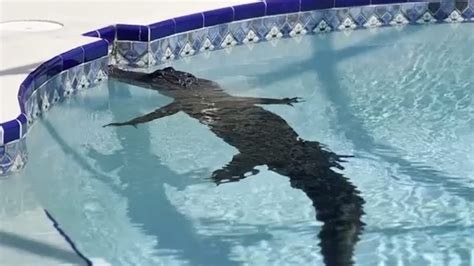
A sizable alligator was apprehended in a Florida backyard pool, bringing an unexpected end to a resident’s peaceful afternoon and highlighting the ongoing interactions between wildlife and human habitats in the state.
A Florida family received an unexpected visitor when an alligator decided to take a dip in their backyard pool. According to a report by WFLA, the incident occurred in Hillsborough County, Florida, prompting a response from local authorities and wildlife officials. The alligator was safely captured and removed from the property, underscoring the challenges and realities of living in close proximity to wildlife in the Sunshine State.
The Hillsborough County Sheriff’s Office responded to a call reporting the alligator lounging in the residential pool. Deputies arrived at the scene and confirmed the presence of the reptile, estimating its length to be around eight feet. Given the potential danger the alligator posed to residents and pets, the Sheriff’s Office contacted the Florida Fish and Wildlife Conservation Commission (FWC) for assistance.
FWC is the primary state agency responsible for managing and conserving Florida’s fish and wildlife resources. Trained FWC officers and contracted nuisance alligator trappers are equipped to safely capture and relocate alligators that pose a threat to public safety. The collaboration between the Sheriff’s Office and FWC ensured the safe removal of the alligator from the residential property.
Upon arrival, the FWC-contracted trapper assessed the situation and developed a plan to capture the alligator without causing harm to either the animal or the surrounding property. Using specialized tools and techniques, the trapper was able to secure the alligator and remove it from the pool. The alligator was then transported to a designated relocation site, where it could live without posing a risk to the community.
“Dealing with nuisance alligators is a common occurrence in Florida, particularly during mating season,” explained FWC spokesperson, Karen Parker. “We work closely with local law enforcement and licensed trappers to ensure these situations are handled safely and efficiently.”
The incident serves as a reminder of the importance of taking precautions and being aware of the potential presence of alligators in residential areas, especially those located near bodies of water. FWC offers guidance and resources to help residents coexist safely with alligators, including tips on how to avoid attracting them to properties and what to do if an alligator is encountered.
Understanding Alligator Behavior and Habitat
Florida is home to a large and thriving alligator population. The American alligator (Alligator mississippiensis) is a native species that plays an important role in the state’s ecosystem. Alligators are typically found in freshwater habitats such as lakes, rivers, swamps, and marshes, but they can also venture into brackish water environments.
Alligator behavior is influenced by a variety of factors, including temperature, food availability, and breeding season. Alligators are most active during warmer months, particularly in the spring and summer, when they are more likely to be seen basking in the sun or searching for food.
During mating season, which typically occurs in the spring, male alligators become more territorial and aggressive. They may engage in displays of dominance, such as bellowing and head-slapping, to attract mates and ward off rivals. Female alligators build nests out of vegetation and lay their eggs in late spring or early summer. The eggs incubate for approximately 65 days, and the female remains close to the nest to protect it from predators.
Living Safely with Alligators
While alligators are an important part of Florida’s natural heritage, they can also pose a threat to humans and pets if they are not treated with caution and respect. FWC recommends the following tips for living safely with alligators:
- Never feed alligators: Feeding alligators can cause them to lose their natural fear of humans and associate people with food. This can lead to dangerous encounters.
- Keep a safe distance from alligators: If you see an alligator, observe it from a distance and do not approach it.
- Supervise children and pets near water: Alligators may prey on small animals, so it is important to keep children and pets away from the water’s edge.
- Swim only in designated swimming areas: Avoid swimming in areas where alligators are known to be present.
- Be aware of your surroundings: Pay attention to signs warning of alligators and be cautious when walking near water.
- Keep yards well-maintained: Clear away brush and vegetation that could provide cover for alligators.
- Do not harass or provoke alligators: It is illegal to harass or provoke alligators in Florida.
Nuisance Alligator Program
FWC operates a Nuisance Alligator Program to address situations where alligators pose a threat to public safety. A nuisance alligator is defined as an alligator that is at least four feet in length and is believed to pose a threat to people, pets, or property.
When a nuisance alligator is reported, FWC dispatches a licensed trapper to assess the situation and capture the alligator if necessary. The trapper is authorized to kill the alligator if it cannot be safely relocated. Alligators that are captured through the Nuisance Alligator Program are typically euthanized, as they cannot be released back into the wild due to the risk of them returning to populated areas.
The Nuisance Alligator Program is funded through the sale of alligator hunting permits and the proceeds from the sale of alligator products. The program plays an important role in managing alligator populations and ensuring public safety in Florida.
The Capture and Relocation Process: A Closer Look
The capture of an alligator in a residential setting is a carefully orchestrated process that prioritizes safety for both the animal and the people involved. When a call comes in to the FWC regarding a nuisance alligator, a licensed trapper is dispatched to the location. These trappers undergo specialized training in alligator capture techniques and are equipped with the necessary tools and equipment to safely handle these large reptiles.
Upon arriving at the scene, the trapper will assess the situation to determine the best course of action. Factors such as the size of the alligator, its location, and the surrounding environment will all be taken into consideration. The trapper’s primary goal is to capture the alligator without causing it undue stress or harm.
Several different methods can be used to capture an alligator, depending on the circumstances. One common technique involves using a snare or a hook to secure the alligator’s head or neck. Once the alligator is secured, the trapper will carefully restrain it and prepare it for transport.
In some cases, it may be necessary to use a tranquilizer to subdue the alligator before it can be safely captured. This is typically only done in situations where the alligator is particularly aggressive or difficult to handle. The use of tranquilizers is carefully regulated by FWC to ensure that the animal is not harmed.
Once the alligator has been captured, it is transported to a designated relocation site. These sites are typically located in remote areas away from human populations. The alligator is released back into the wild, where it can live without posing a threat to public safety. However, as stated earlier, nuisance alligators are usually euthanized due to the unlikelihood of successful relocation and the risk of them returning to populated areas.
Increased Human-Wildlife Interactions: A Growing Concern
The incident involving the alligator in the backyard pool is just one example of the increasing interactions between humans and wildlife in Florida. As the state’s population continues to grow and development expands into previously undeveloped areas, the boundaries between human habitats and wildlife habitats are becoming increasingly blurred. This can lead to a variety of conflicts, including encounters with alligators, bears, snakes, and other animals.
Several factors contribute to the increase in human-wildlife interactions. Habitat loss is a major driver, as development reduces the amount of natural habitat available for wildlife. This forces animals to seek out food and shelter in closer proximity to humans.
Another factor is the increasing popularity of outdoor recreation. More and more people are engaging in activities such as hiking, camping, and fishing, which can bring them into contact with wildlife. While these activities can be enjoyable, they also increase the risk of encounters with potentially dangerous animals.
Climate change is also playing a role in human-wildlife interactions. Changes in temperature and rainfall patterns can alter the distribution and behavior of wildlife, leading to increased conflicts with humans. For example, rising sea levels can inundate coastal habitats, forcing animals to move inland and into populated areas.
Addressing the issue of human-wildlife interactions requires a multi-faceted approach. It is important to protect and restore natural habitats to provide wildlife with adequate space and resources. It is also important to educate the public about how to coexist safely with wildlife and to take precautions to avoid attracting animals to residential areas.
Community Reactions and Preventative Measures
The news of the alligator in the pool spread quickly through the Hillsborough County community, sparking a mix of concern and curiosity. Many residents expressed surprise at the incident, while others noted that it was not entirely unexpected given the area’s proximity to natural waterways.
“You always hear about alligators in Florida, but you don’t really expect to find one in your neighbor’s pool,” said Maria Rodriguez, a resident of the neighborhood where the alligator was captured. “It’s a little scary, but it’s also a reminder that we need to be aware of our surroundings and take precautions.”
Following the incident, local authorities and FWC officials reiterated the importance of taking preventative measures to minimize the risk of alligator encounters. These measures include keeping yards well-maintained, avoiding feeding alligators, and supervising children and pets near water.
“We want to remind residents that alligators are a natural part of Florida’s ecosystem,” said Sheriff Chad Chronister of the Hillsborough County Sheriff’s Office. “By taking some simple precautions, we can coexist safely with these animals and avoid potentially dangerous situations.”
The Broader Ecological Significance of Alligators
While alligators can sometimes be perceived as a threat to humans, they are also an important part of the Florida ecosystem. As apex predators, alligators play a crucial role in maintaining the balance of their environment. They help to control populations of other animals, such as fish, turtles, and birds, and they also create habitat for other species.
Alligators are known as “ecosystem engineers” because of their ability to modify their environment to benefit themselves and other organisms. For example, alligators create “gator holes,” which are deep depressions in the wetlands that provide refuge for fish and other aquatic animals during dry periods. These gator holes also serve as important breeding grounds for many species.
Alligators also play a role in nutrient cycling. When they feed on other animals, they break down organic matter and release nutrients back into the environment. These nutrients can then be used by plants and other organisms.
The conservation of alligators is therefore important not only for their own sake but also for the health of the entire ecosystem. By protecting alligator habitats and managing alligator populations, we can help to ensure the long-term health and resilience of Florida’s natural environment.
Tourism and Alligators: A Delicate Balance
Alligators are a popular attraction for tourists visiting Florida. Many visitors are eager to see these iconic reptiles in their natural habitat. However, the presence of alligators can also pose a challenge for the tourism industry.
It is important to strike a balance between providing opportunities for tourists to see alligators and ensuring their safety. Many tour operators offer guided tours of alligator habitats, where visitors can observe alligators from a safe distance. These tours can be a valuable source of revenue for local communities while also providing educational opportunities for tourists.
It is also important to educate tourists about the potential risks associated with alligators and to encourage them to take precautions to avoid encounters. Signs warning of alligators should be posted in areas where they are known to be present, and tourists should be advised to keep a safe distance from the water’s edge.
By managing alligator populations responsibly and educating the public about alligator safety, Florida can continue to attract tourists while also protecting its natural environment.
Legal Ramifications and Penalties
In Florida, it is illegal to feed, harass, injure, or kill alligators, except under certain circumstances. Violators of these laws can face fines, imprisonment, and other penalties.
The Florida Fish and Wildlife Conservation Commission (FWC) is responsible for enforcing these laws. FWC officers patrol alligator habitats and investigate reports of illegal activity. They also work to educate the public about alligator conservation and safety.
Individuals who encounter a nuisance alligator should report it to the FWC. The FWC will dispatch a licensed trapper to assess the situation and take appropriate action.
The Future of Alligator Management in Florida
The management of alligators in Florida is an ongoing challenge. As the state’s population continues to grow and development expands into previously undeveloped areas, the interactions between humans and alligators are likely to increase.
FWC is committed to managing alligator populations in a way that protects both human safety and the health of the ecosystem. This includes monitoring alligator populations, conducting research on alligator behavior, and educating the public about alligator safety.
FWC also works closely with local communities to address alligator-related issues. This includes providing technical assistance to landowners, responding to reports of nuisance alligators, and developing educational programs for schools and community groups.
By working together, FWC, local communities, and the public can help to ensure that alligators continue to thrive in Florida for generations to come.
FAQ about Alligators in Florida
-
What should I do if I see an alligator in my backyard?
- If you see an alligator in your backyard, remain calm and keep a safe distance. Do not approach or attempt to interact with the alligator. Bring children and pets indoors immediately. Contact the Florida Fish and Wildlife Conservation Commission (FWC) or your local authorities to report the sighting. They will assess the situation and take appropriate action, such as dispatching a licensed trapper if the alligator poses a threat.
-
Is it safe to swim in Florida lakes and rivers?
- While many Florida lakes and rivers are safe for swimming, it’s crucial to be aware of the potential presence of alligators. Swim only in designated swimming areas and during daylight hours, as alligators are most active at dawn and dusk. Avoid swimming in areas with dense vegetation or where alligators have been sighted. Never swim near areas where people might be feeding alligators, as this can make them associate humans with food.
-
What is the Nuisance Alligator Program?
- The Nuisance Alligator Program is managed by the FWC to address situations where alligators pose a threat to people, pets, or property. A nuisance alligator is defined as one that is at least four feet in length and believed to be a danger. When reported, the FWC dispatches a licensed trapper to capture the alligator. Due to the difficulty of relocating alligators and the risk of them returning to populated areas, nuisance alligators are typically euthanized.
-
Why is it illegal to feed alligators?
- Feeding alligators is illegal in Florida because it can alter their natural behavior and make them dangerous to humans. When alligators are fed, they lose their fear of humans and begin to associate people with food. This can lead them to approach humans aggressively in search of food, increasing the risk of attacks. Additionally, feeding alligators can cause them to congregate in certain areas, further increasing the likelihood of human-alligator encounters.
-
How can I prevent alligators from coming onto my property?
- There are several steps you can take to prevent alligators from coming onto your property. Keep your yard well-maintained by mowing the lawn regularly and trimming bushes and shrubs. Remove any standing water sources, such as bird baths or empty containers, as these can attract alligators. Avoid feeding any animals, including pets, outdoors, as the food can also attract alligators. If your property borders a body of water, consider installing a fence to prevent alligators from entering your yard.
Additional Context and Information
Alligator Attacks: Understanding the Risks
While alligator attacks are relatively rare in Florida, they can occur. It’s essential to understand the circumstances that may lead to an attack and take steps to minimize the risk. Alligators are opportunistic predators, meaning they will typically prey on animals that are easily accessible. Small children and pets are particularly vulnerable, as they may be perceived as easy targets.
Most alligator attacks occur near the water’s edge, as alligators are ambush predators that prefer to strike from the water. Attacks are also more likely to occur during mating season, when alligators are more territorial and aggressive.
If you are attacked by an alligator, fight back aggressively. Aim for the eyes, nose, and throat, as these are sensitive areas. Try to escape to a safe location as quickly as possible. Seek medical attention immediately after an alligator attack, as alligator bites can cause serious injuries and infections.
Alligator Conservation Efforts
The American alligator was once an endangered species, but thanks to successful conservation efforts, it has made a remarkable recovery. The alligator was listed as endangered in 1967, but due to habitat protection and regulations on hunting, its population has rebounded significantly. In 1987, the alligator was removed from the endangered species list, although it is still protected by state and federal laws.
The conservation of alligators has had a positive impact on the entire Florida ecosystem. Alligators play a crucial role in maintaining the health and balance of wetlands, and their recovery has helped to restore these valuable habitats.
The Cultural Significance of Alligators
Alligators have long been a part of Florida’s cultural heritage. Native American tribes revered alligators and incorporated them into their mythology and art. Early European settlers also recognized the alligator’s importance and used its skin for leather and its meat for food.
Today, alligators remain a symbol of Florida and are featured in many aspects of the state’s culture, from tourism to sports. The University of Florida’s sports teams are known as the “Gators,” and the alligator is a popular motif in Florida art and design.
Research and Monitoring of Alligator Populations
The Florida Fish and Wildlife Conservation Commission (FWC) conducts ongoing research and monitoring of alligator populations to ensure their long-term health and sustainability. This research includes tracking alligator populations, studying their behavior, and assessing the impact of human activities on their habitats.
FWC uses a variety of methods to monitor alligator populations, including aerial surveys, mark-recapture studies, and citizen science programs. Aerial surveys involve flying over alligator habitats and counting the number of alligators observed. Mark-recapture studies involve capturing alligators, tagging them, and then releasing them back into the wild. By tracking the movements of tagged alligators, researchers can learn more about their habitat use and population dynamics.
Citizen science programs allow members of the public to contribute to alligator research by reporting sightings of alligators and providing information about their behavior. This information helps FWC to track alligator populations and identify potential problems.
The data collected through research and monitoring efforts is used to inform management decisions and ensure that alligator populations remain healthy and sustainable.
The Economic Impact of Alligators
Alligators have a significant economic impact on Florida, generating revenue through tourism, hunting, and the sale of alligator products.
As mentioned earlier, alligators are a popular attraction for tourists visiting Florida. Many visitors come to the state specifically to see alligators in their natural habitat, and they spend money on tours, accommodations, and other goods and services.
Alligator hunting is also a significant source of revenue for the state. FWC issues alligator hunting permits each year, and hunters spend money on licenses, equipment, and travel expenses.
The sale of alligator products, such as leather goods and meat, also contributes to the state’s economy. Alligator leather is used to make a variety of products, including shoes, belts, and handbags, and it is sold both domestically and internationally. Alligator meat is also becoming increasingly popular, and it is served in restaurants and sold in grocery stores.
The economic impact of alligators underscores their importance to Florida and provides further justification for their conservation and management.
The Ethics of Alligator Management
The management of alligators raises a number of ethical considerations. Some people believe that alligators should be left alone and allowed to live in their natural habitat without human interference. Others believe that humans have a responsibility to manage alligator populations to protect public safety.
There is no easy answer to these ethical questions. However, it is important to consider the potential consequences of different management approaches and to strive for solutions that balance the needs of both humans and alligators.
FWC takes a balanced approach to alligator management, striving to protect both human safety and the health of alligator populations. This includes educating the public about alligator safety, responding to reports of nuisance alligators, and conducting research to improve our understanding of alligator behavior and ecology.
By working together, we can ensure that alligators continue to thrive in Florida while also protecting the safety and well-being of its residents and visitors.




![Cathie Wood Dumps $22.8M of [Stock Ticker] Near Peak](https://generasitekno.com/wp-content/uploads/2025/06/unnamed-file-478-150x150.jpg)




